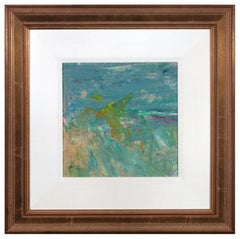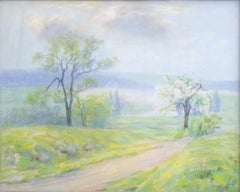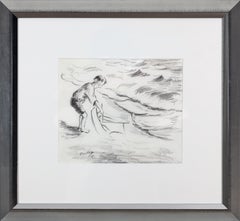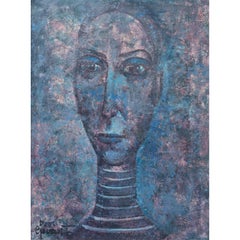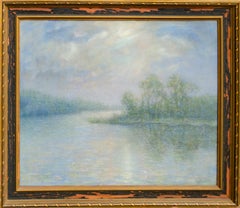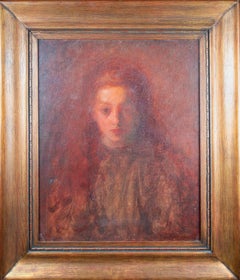Francesco Spicuzza Art
Italian, American, 1883-1962
Italian-born Francesco Spicuzza was primarily a Wisconsin painter who did portraits, still-lives and local landscapes. He spent the first part of his life in near-poverty to become a painter. An eternal optimist, in 1917, the artist reported: "I am happy and my only ambition now is to paint better and better until I shall have reached the measure of the best of which I am capable." (Spicuzza, 1917, p. 22). His predilection for beach scenes germinated early: reportedly, the five-year-old boy first drew the outlines of his father's fishing boat in the sand on the seashore near their home in Sicily. After setting himself up as a fruit peddler in Milwaukee, Spicuzza's father sent for his family when Francesco was eight years old.
In 1899 or 1900, Spicuzza began studying drawing and anatomy under Robert Schade (1861-1912), a painter of panoramas who had been trained in Munich under Carl Theodor von Piloty. Spicuzza was also taught by Alexander Mueller (1872-1935), a product of the Weimar and Munich academies.
The earliest influences in his work appear to be from Edward H. Potthast and Maurice Prendergast, though Spicuzza never mentioned either artist. Already in August 1910, Spicuzza was described in a newspaper as "one of the most talented of Milwaukee's rising workers." He undoubtedly received lasting inspiration from his one summer study period in 1911 with John F. Carlson at the Art Students League's Summer School in Woodstock, New York. Although he executed numerous still-lives and an occasional religious work, Spicuzza is best known for his Milwaukee beach scenes populated with frolicking bathers in multi-colored attire, not unlike the images of Potthast, who used a similar technique. These beach genre scenes reflect the attitude of American impressionists who depicted the more pleasant side of life.
Spicuzza manipulated a successful balance of rich pigment applied in varying degrees of impasto texture with subtle nuances of hue. Working all'aperto, he sought "the soft enticing shades of yellow, blue, green, pink and lavender . . . to get the effects of bright glistening summer air." (L.E.S., n.d.). As a painter whose color not only derived from direct observation but also from a personal theory of color symbolism, Spicuzza traded the linear approach of lithography for dynamic patches of brilliant color. Like Prendergast, he would often tilt the angle of the picture plane to bring the viewer's position above the scene.
Spicuzza spent a great deal of time painting en plein air and by 1925 he began summering at Big Cedar Lake, near West Bend, Wisconsin to gather his subject matter. During the difficult era of the Depression, patrons came to Spicuzza's aid and during the 40s, he taught housewives, businessmen and students at the Milwaukee Art Institute, the Milwaukee Art Center, and in his studio. In the following decade, although his kind of art was no longer popular in the "make-it-or-break-it" New York gallery world, Spicuzza enjoyed regular patronage and sales.
Bio by Richard H. Love and Michael Preston Worley, Ph.D.(Biography provided by J Gold Fine Art)
to
17
6
3
11
4
2
3
7
1
3
3
Overall Height
to
Overall Width
to
2
1
11
5
3
3
3
2
2
2
2
1
1
1
1
1
1
1
1
1
1
1
17
1
4
1
6
1
1
17
6,886
3,213
2,514
1,217
8
8
7
5
5
Artist: Francesco Spicuzza
'My Mother' Original Oil Painting Signed by Francesco Spicuzza
By Francesco Spicuzza
Located in Milwaukee, WI
Signed lower right by the artist.
Francesco J. Spicuzza, born in Sicily on July 23, 1883, came to America at the age of 8. He supported himself as a fruit peddler until a newspaperman gave him $4 a week to go to school...
Category
1910s Francesco Spicuzza Art
Materials
Oil
"Lake Michigan Shore, " Oil on Board, Signed
By Francesco Spicuzza
Located in Milwaukee, WI
"Lake Michigan Shore" is an original oil painting on board by Francesco Spicuzza. The artist shows the impact of Impressionism in his landscapes from around 1930. "Lake Michigan Shor...
Category
1930s Francesco Spicuzza Art
Materials
Board, Oil
"Rocky Shore, " Oil on Board Abstract Landscape Signed
By Francesco Spicuzza
Located in Milwaukee, WI
"Rocky Shore" is an original oil painting on board by Francesco Spicuzza. The artist signed the piece with his signature stamp in the lower right. Land and water are clearly demarcat...
Category
1930s Francesco Spicuzza Art
Materials
Board, Oil
Beautiful large impressionist pastel by Francesco Spicuzza
By Francesco Spicuzza
Located in Larchmont, NY
Francesco Spicuzza (American, 1883-1962)
Untitled Landscape, 20th century
Pastel on paper
Sight size: 24 x 30 in.
Framed: 26 1/4 x 32 3/8 in.
Signed lower right: Spicuzza
Italian-born Francesco Spicuzza was primarily a Wisconsin painter who did portraits, still-lives and local landscapes. He spent the first part of his life in near-poverty to become a painter. An eternal optimist, in 1917, the artist reported: "I am happy and my only ambition now is to paint better and better until I shall have reached the measure of the best of which I am capable." (Spicuzza, 1917, p. 22). His predilection for beach scenes germinated early: reportedly, the five-year-old boy first drew the outlines of his father's fishing boat in the sand on the seashore near their home in Sicily. After setting himself up as a fruit peddler in Milwaukee, Spicuzza's father sent for his family when Francesco was eight years old. For the following six years the boy was unable to attend school because of his job in his father's fruit and vegetable business. The poor lad suffered a caved-in shoulder from carrying a heavy wooden crate.
The young Spicuzza was aided by moral and financial support from a sympathetic Milwaukee businessman named John Cramer, publisher and editor of the Evening Wisconsin, who raised Spicuzza's salary as a newspaper assembler so that he could attend school. In 1899 or 1900, Spicuzza began studying drawing and anatomy under Robert Schade (1861-1912), a painter of panoramas who had been trained in Munich under Carl Theodor von Piloty. Spicuzza was also taught by Alexander Mueller (1872-1935), a product of the Weimar and Munich academies. Mueller realized Spicuzza was a colorist and encouraged that orientation (Madle, 1961). Spicuzza found it beneficial to accept an apprenticeship in a lithographic studio for $8 a week, which demanded most of his time. During the St. Louis Universal Exposition in 1904, still a struggling student, Spicuzza attended the fair, thanks to Cramer. It was not long before Spicuzza received a twenty-five dollar portrait commission, and this inaugural success led to new commissions and allowed him to continue as a painter.
The earliest influences in his work appear to be from Edward H. Potthast and Maurice Prendergast, though Spicuzza never mentioned either artist. Already in August 1910, Spicuzza was described in a newspaper as "one of the most talented of Milwaukee's rising workers." He undoubtedly received lasting inspiration from his one summer study period in 1911 with John F. Carlson at the Art Students League's Summer School in Woodstock, New York. Certainly Spicuzza would have picked up spontaneity in handling the brush from Carlson. Although he executed numerous still-lives and an occasional religious work, Spicuzza is best known for his Milwaukee beach scenes populated with frolicking bathers in multi-colored attire, not unlike the images of Potthast, who used a similar technique. Many of these are small, preparatory works on canvas board executed between 1910 and 1915. Frequently with even greater animation than Potthast, Spicuzza produced moving images of youthful energy and uninhibited child's play. These beach genre scenes reflect the attitude of American impressionists who depicted the more pleasant side of life.
Spicuzza manipulated a successful balance of rich pigment applied in varying degrees of impasto texture with subtle nuances of hue. Working all'aperto, he sought "the soft enticing shades of yellow, blue, green, pink and lavender . . . to get the effects of bright glistening summer air." (L.E.S., n.d.). As a painter whose color not only derived from direct observation but also from a personal theory of color symbolism, Spicuzza traded the linear approach of lithography for dynamic patches of brilliant color. Like Prendergast, he would often tilt the angle of the picture plane to bring the viewer's position above the scene.
Spicuzza was unable to enter the 1913 Armory Show or the Panama-Pacific International Exposition two years later but he did submit work to the annual exhibitions of the Pennsylvania Academy of the Fine Arts and those of the Art Institute of Chicago. His first important award was the bronze medal presented by the St. Paul Institute in 1913, which was followed by the silver medal two years later. Before long, Spicuzza had acquired a greater sense of security in his profession and was described by a writer in International Studio (April 1917) as "an independent artist with an assured future. His pastels and water-colours are poetic and joyous bits of nature with a genuine out-of-door feeling." In 1918, his Spirit of Youth, exhibited at the National Academy of Design, sold for $112.50. Four years later, the artist achieved his greatest local recognition by winning the gold medal from the Milwaukee Art Institute.
Spicuzza spent a great deal of time painting en plein air and by 1925 he began summering at Big Cedar Lake, near West Bend, Wisconsin to gather his subject matter. Easter Morning (1926) owes something to the Symbolist movement, with its figure of Christ appearing over a seascape. During the difficult era of the Depression, patrons came to Spicuzza's aid and during the 40s, he taught housewives, businessmen and students at the Milwaukee Art Institute, the Milwaukee Art Center, and in his private studio. In the following decade, although his kind of art was no longer popular in the "make-it-or-break-it" New York gallery world, Spicuzza enjoyed regular patronage and sales. His beach scenes became more static and he would experiment with modernist techniques. Spicuzza died at the age of seventy-eight.
Sources:
L.E.S., "Do Colors Change a Person's disposition? Experiments of a Milwaukee Artist...
Category
20th Century American Modern Francesco Spicuzza Art
Materials
Paper, Pastel
Boy Launching a Sailboat
By Francesco Spicuzza
Located in Milwaukee, WI
Graphite and charcoal on paper signed by the artist.
7.38" x 8.63"
16.75" x 15.5" frame
Framed to conservation standards. Float mounted on 100% cotton matboard and glazed in UF5 Plexiglass that filters 99% of UV Rays to ensure the preservation of the piece. All housed in a bold miter jointed bevel frame in distressed silver finish with reflective accents.
Francesco J. Spicuzza, born in Sicily on July 23, 1883, came to America at the age of 8. He supported himself as a fruit peddler until a newspaperman gave him $4 a week to go to school. He attended classes at the Milwaukee Art Students League, where he studied under Alexander Mueller. There he learned to paint in the then-fashionable "Munich School" technique, with detailed realism in heavy browns and grayed-out hues. Spicuzza completed eight grades in four years, and then in 1911, three businessmen advanced him enough money to allow him to study in New York under artist and teacher John Carlson.
It was during this time that Spicuzza changed his style of painting, developing an impressionistic use of color, form and atmospheric renditions. After a period of grinding poverty, one of Spicuzza's pictures won a major New York competition. It was the first of 60 wins, both in the U.S. and Paris. He became a fashionable painter, and many of the leading collections have his work. Spicuzza's typical works were beach scenes, still life, landscapes and portraits done in pastels, oils, ink, charcoal and watercolors. Much of his work traced the history of Milwaukee in the early 1900s. He was probably best known for his scenes of women and children splashing in the waves...
Category
Mid-20th Century Francesco Spicuzza Art
Materials
Graphite, Charcoal
'My Father' Original Oil Painting Signed by Francesco Spicuzza
By Francesco Spicuzza
Located in Milwaukee, WI
Signed lower right by the artist.
Francesco J. Spicuzza, born in Sicily on July 23, 1883, came to America at the age of 8. He supported himself as a fruit peddler until a newspaperman gave him $4 a week to go to school. He attended classes at the Milwaukee Art Students League, where he studied under Alexander Mueller. There he learned to paint in the then-fashionable "Munich School" technique, with detailed realism in heavy browns and grayed-out hues. Spicuzza completed eight grades in four years, and then in 1911, three businessmen advanced him enough money to allow him to study in New York under artist and teacher John Carlson.
It was during this time that Spicuzza changed his style of painting, developing an impressionistic use of color, form and atmospheric renditions. After a period of grinding poverty, one of Spicuzza's pictures won a major New York competition. It was the first of 60 wins, both in the U.S. and Paris. He became a fashionable painter, and many of the leading collections have his work. Spicuzza's typical works were beach scenes, still life, landscapes and portraits done in pastels, oils, ink, charcoal and watercolors. Much of his work traced the history of Milwaukee in the early 1900s. He was probably best known for his scenes of women and children splashing in the waves...
Category
1910s Francesco Spicuzza Art
Materials
Oil
"Cabin on Lake Michigan Shore, " Oil on Board signed by Francesco Spicuzza
By Francesco Spicuzza
Located in Milwaukee, WI
"Cabin on Lake Michigan Shore" is an original oil painting on board by Francesco Spicuzza. The artist signed the piece in the lower left. It depicts a small cabin on the lakeshore surrounded by bright vegetation.
14" x 20" art
22 3/4" x 29" frame
Francesco J. Spicuzza, born in Sicily on July 23, 1883, came to America at the age of 8. He supported himself as a fruit peddler until a newspaperman gave him $4 a week to go to school. He attended classes at the Milwaukee Art Students League, where he studied under Alexander Mueller. There he learned to paint in the then-fashionable "Munich School" technique, with detailed realism in heavy browns and grayed-out hues. Spicuzza completed eight grades in four years, and then in 1911, three businessmen advanced him enough money to allow him to study in New York under artist and teacher John Carlson. It was during this time that Spicuzza changed his style of painting, developing an impressionistic use of color, form and atmospheric renditions. After a period of grinding poverty, one of Spicuzza's pictures won a major New York competition. It was the first of 60 wins, both in the U.S. and Paris. He became a fashionable painter, and many of the leading collections have his work. Spicuzza's typical works were beach scenes, still life, landscapes and portraits done in pastels, oils, ink, charcoal and watercolors. Much of his work traced the history of Milwaukee in the early 1900s. He was probably best known for his scenes of women and children splashing in the waves...
Category
1930s Francesco Spicuzza Art
Materials
Board, Oil
"Flowers in Vase with Handles, " Pastel on Paperboard signed by F. Spicuzza
By Francesco Spicuzza
Located in Milwaukee, WI
"Flowers in Vase with Handles" is an original pastel drawing on paperboard by Francesco Spicuzza. The artist signed the piece in the lower right. This drawing depicts a bouquet of wa...
Category
1930s Francesco Spicuzza Art
Materials
Pastel, Board, Paper
"Lake Michigan Bathers, " Pencil, Reverse, & Photo signed by Francesco Spicuzza
By Francesco Spicuzza
Located in Milwaukee, WI
"Lake Michigan Bathers" is an original pencil sketch by Francesco Spicuzza. The artist signed the piece in the lower right. On the reverse is a silver gelatin photo print...
Category
1910s Francesco Spicuzza Art
Materials
Black and White, Silver Gelatin, Carbon Pencil
"Couple on Bench at the Beach" Pastel on Paperboard signed by Francesco Spicuzza
By Francesco Spicuzza
Located in Milwaukee, WI
"Couple on Bench at the Beach" is an original pastel drawing on paperboard by Francesco Spicuzza. The artist signed the piece in the lower left. This drawing depicts two figures sitting on a bench in front of a body of water. The artist used mostly pastel colors for this piece.
6 7/8" x 9 7/8" art
18 1/2" x 21 3/8" frame
Francesco J. Spicuzza, born in Sicily on July 23, 1883, came to America at the age of 8. He supported himself as a fruit peddler until a newspaperman gave him $4 a week to go to school. He attended classes at the Milwaukee Art Students League, where he studied under Alexander Mueller. There he learned to paint in the then-fashionable "Munich School" technique, with detailed realism in heavy browns and grayed-out hues. Spicuzza completed eight grades in four years, and then in 1911, three businessmen advanced him enough money to allow him to study in New York under artist and teacher John Carlson. It was during this time that Spicuzza changed his style of painting, developing an impressionistic use of color, form and atmospheric renditions. After a period of grinding poverty, one of Spicuzza's pictures won a major New York competition. It was the first of 60 wins, both in the U.S. and Paris. He became a fashionable painter, and many of the leading collections have his work. Spicuzza's typical works were beach scenes, still life, landscapes and portraits done in pastels, oils, ink, charcoal and watercolors. Much of his work traced the history of Milwaukee in the early 1900s. He was probably best known for his scenes of women and children splashing in the waves...
Category
1910s Impressionist Francesco Spicuzza Art
Materials
Pastel, Board, Paper
"Snowcapped Mountain, " Oil on Board signed by Francesco Spicuzza
By Francesco Spicuzza
Located in Milwaukee, WI
"Snowcapped Mountain" is an original oil painting on board by Francesco Spicuzza. The artist signed it with his signature stamp in the lower left. This painting depicts a mountain pe...
Category
1930s Francesco Spicuzza Art
Materials
Board, Oil
"Boats in Berlin Harbor, " Pastel on Cheesecloth by Francesco Spicuzza
By Francesco Spicuzza
Located in Milwaukee, WI
"Boats in Berlin Harbor" is an original pastel painting on cheesecloth. Small tugboats push across the Berlin harbor as a gauzy cityscape watches from behind.
Image: 25" x 33"
Frame...
Category
1920s American Modern Francesco Spicuzza Art
Materials
Pastel
"Lake Michigan Beach Scene, " Oil on Canvas Seascape signed by Francesco Spicuzza
By Francesco Spicuzza
Located in Milwaukee, WI
"Lake Michigan Beach Scene" is an original oil painting by Francesco Spicuzza. The artist painted this scene on canvas and then glued that canvas to a b...
Category
1930s Francesco Spicuzza Art
Materials
Oil, Board, Canvas
"Monkey Island at Washington Park Zoo" Graphite & Charcoal by Francesco Spicuzza
By Francesco Spicuzza
Located in Milwaukee, WI
"Monkey Island at Washington Park Zoo" is an original graphite and charcoal drawing on paper by Francesco Spicuzza. It depicts a number of figures gazing out at a monkey enclosure at a zoo. The artist signed the piece in the lower left.
8 1/2" x 11 3/4" art
17 1/4" x 21 1/8" frame
Francesco J. Spicuzza, born in Sicily on July 23, 1883, came to America at the age of 8. He supported himself as a fruit peddler until a newspaperman gave him $4 a week to go to school. He attended classes at the Milwaukee Art Students League, where he studied under Alexander Mueller. There he learned to paint in the then-fashionable "Munich School" technique, with detailed realism in heavy browns and grayed-out hues. Spicuzza completed eight grades in four years, and then in 1911, three businessmen advanced him enough money to allow him to study in New York under artist and teacher John Carlson. It was during this time that Spicuzza changed his style of painting, developing an impressionistic use of color, form and atmospheric renditions. After a period of grinding poverty, one of Spicuzza's pictures won a major New York competition. It was the first of 60 wins, both in the U.S. and Paris. He became a fashionable painter, and many of the leading collections have his work. Spicuzza's typical works were beach scenes, still life, landscapes and portraits done in pastels, oils, ink, charcoal and watercolors. Much of his work traced the history of Milwaukee in the early 1900s. He was probably best known for his scenes of women and children splashing in...
Category
1950s Francesco Spicuzza Art
Materials
Charcoal, Graphite, Paper
"Portrait of the Artist's Mother-In-Law, " Pastel signed by Francesco Spicuzza
By Francesco Spicuzza
Located in Milwaukee, WI
"Portrait of the Artist's Mother-in-Law" is an original pastel drawing by Francesco Spicuzza. The artist signed the piece in the lower right. This drawing depicts an elderly woman in beige clothing...
Category
Early 1900s Francesco Spicuzza Art
Materials
Pastel
"Children Playing in Water-Lake Michigan (The Splash), " a Siver Gelatin Photo
By Francesco Spicuzza
Located in Milwaukee, WI
"Children Playing in Water-Lake Michigan (The Splash)" is a black and white silver gelatin photo (with grid) by Francesco Spicuzza. It depicts four children playing and splashing in a lake.
12 1/8" x 11" photo
17 1/4" x 17 1/4" frame
Francesco J. Spicuzza, born in Sicily on July 23, 1883, came to America at the age of 8. He supported himself as a fruit peddler until a newspaperman gave him $4 a week to go to school. He attended classes at the Milwaukee Art Students League, where he studied under Alexander Mueller. There he learned to paint in the then-fashionable "Munich School" technique, with detailed realism in heavy browns and grayed-out hues. Spicuzza completed eight grades in four years, and then in 1911, three businessmen advanced him enough money to allow him to study in New York under artist and teacher John Carlson. It was during this time that Spicuzza changed his style of painting, developing an impressionistic use of color, form and atmospheric renditions. After a period of grinding poverty, one of Spicuzza's pictures won a major New York competition. It was the first of 60 wins, both in the U.S. and Paris. He became a fashionable painter, and many of the leading collections have his work. Spicuzza's typical works were beach scenes, still life, landscapes and portraits done in pastels, oils, ink, charcoal and watercolors. Much of his work traced the history of Milwaukee in the early 1900s. He was probably best known for his scenes of women and children splashing in the waves...
Category
Early 20th Century Other Art Style Francesco Spicuzza Art
Materials
Photographic Paper
"Self Portrait, " Oil on Masonite signed by Francesco Spicuzza
By Francesco Spicuzza
Located in Milwaukee, WI
"Self Portrait" is an original oil painting on masonite board by Francesco Spicuzza. The artist signed the piece in the lower left. It depicts the artist holding a pipe in front of a...
Category
1940s Francesco Spicuzza Art
Materials
Masonite, Oil
Related Items
Weltevreden, Kebon Sirih, & Vlucht voor de bui (Fleeing the rain)
Located in Amsterdam, NL
Weltevreden, Kebon Sirih, & Vlucht voor de bui (Fleeing the rain)
Executed between February 20 and March 2, 1918
Double sided drawing in graphite pencil on paper
Images: c. 33 x 5...
Category
1910s Art Nouveau Francesco Spicuzza Art
Materials
Paper, Graphite
Free Shipping
H 19.3 in W 23.63 in D 1.19 in
Door Gevaert (b. 1911/17, Kortrijk/Belgium), Portrait of a Woman
Located in Greding, DE
Depiction of a woman's head with necklace in impasto color application in blue and pink tones. Bottom left signed Door Gevaert. Image size: 78 x 58 cm. Oil on canvas; profiled wooden...
Category
20th Century Francesco Spicuzza Art
Materials
Oil
H 39.38 in W 31.5 in D 2.37 in
Paul Schürch (1886-1939) - Romantic Landscape Drawing 1917 Solothurn Switzerland
Located in Meinisberg, CH
Paul Schürch
(Swiss, ∗ 14.2.1886 Wangen b. Olten, † 11.12.1939 Bern)
Romantic Landscape in area of Solothurn, Switzerland
• Charcoal/Pencil drawing delicately heightened in various...
Category
1910s Naturalistic Francesco Spicuzza Art
Materials
Laid Paper, Pencil, Pastel, Charcoal
Free Shipping
H 11.42 in W 17.92 in D 0.16 in
Untitled (Houses and Railroad Tracks)
By Harry Lane
Located in Los Angeles, CA
Untitled (Houses and Railroad Tracks), c. 1940s, oil on canvas board, signed lower right, 16 x 20 inches, presented in a newer frame
This work is part of our exhibition America Coas...
Category
1940s American Modern Francesco Spicuzza Art
Materials
Oil, Board
Male and female portrait, both in silk kimono, possibly textile dealers
By Christoffel Lubieniecki
Located in Amsterdam, NL
CHRISTOFFEL LUBIENIECKI (1659-1729)
Pair of portraits of a gentleman and a lady, both in silk kimono, before a country house (circa 1680)
Indistinctly signed “C.......” on a box under the man’s left hand
Oil on canvas, 79.5 x 67 cm each
Both sitters are portrayed wearing a silk “Japanese” coat. During the second half of the seventeenth the Japanese silk coat, an adapted Japanese kimono, became a real vogue in the Dutch elite. The exclusive Dutch trade contacts with Japan can explain the popularity of the kimono-style silk coats in the Netherlands. Everybody who could afford one, dressed in such a fashionable and comfortable coat and, like the present sitters, some proud owners had themselves portrayed in a “Japanese” coat often together with an oriental carpet to underline their standing and international connections. These portraits are the work of the Polish-born portraitist Christoffel Lubieniecki (also known as Lubienitski, Lubinitski or Lubiniecki)
Lubieniecki was first trained in Hamburg under Julian Stuhr and after 1675 in Amsterdam under Adriaen Backer and Gerard de Lairesse. He specialized in landscapes, generally of an Italianate character, and in portraits. The loving execution of these contented burghers, enjoying the garden vistas of their country house, places him alongside Amsterdam portraitists such as Constantijn Netscher and Michiel van Musscher...
Category
1680s Old Masters Francesco Spicuzza Art
Materials
Canvas, Oil
Free Shipping
H 31.34 in W 26.38 in D 1.97 in
Sailboats and Sailing Ship in Seascape early 20th Century Oil Painting Framed
Located in Stockholm, SE
This artwork showcases the beauty of sailing boats and ships sailing gracefully on the sea waters. The artist's attention to detail is evident in the intricate depiction of the ships...
Category
Early 20th Century Realist Francesco Spicuzza Art
Materials
Wood, Oil, Cardboard
Early English watercolour, Figures chatting by a cottage near a river
By William Payne
Located in Harkstead, GB
A delightful composition by this master watercolourist.
William Payne (1760-1830)
Figures chating by a cottage and stream, a rivermouth beyond
Watercolour and touches of charcoal
5½...
Category
Early 19th Century English School Francesco Spicuzza Art
Materials
Watercolor, Pencil, Charcoal, Paper
William Jacobs "Urban Scene II", original pastel on paper
By William Jacobs
Located in Glenview, IL
"Urban Scene II" by noted Chicago painter William Jacobs (1897 - 1973) is a pastel on paper created in 1972. The artwork is signed and dated in pencil by t...
Category
1970s American Modern Francesco Spicuzza Art
Materials
Pastel
H 5 in W 7 in D 0.01 in
Portrait of a Lady with a Chiqueador
Located in New York, NY
Provenance: Torres Family Collection, Asunción, Paraguay, ca. 1967-2017
While the genre of portraiture flourished in the New World, very few examples of early Spanish colonial portraits have survived to the present day. This remarkable painting is a rare example of female portraiture, depicting a member of the highest echelons of society in Cuzco during the last quarter of the 17th century. Its most distinctive feature is the false beauty mark (called a chiqueador) that the sitter wears on her left temple. Chiqueadores served both a cosmetic and medicinal function. In addition to beautifying their wearers, these silk or velvet pouches often contained medicinal herbs thought to cure headaches.
This painting depicts an unidentified lady from the Creole elite in Cuzco. Her formal posture and black costume are both typical of the established conventions of period portraiture and in line with the severe fashion of the Spanish court under the reign of Charles II, which remained current until the 18th century. She is shown in three-quarter profile, her long braids tied with soft pink bows and decorated with quatrefoil flowers, likely made of silver. Her facial features are idealized and rendered with great subtly, particularly in the rosy cheeks.
While this portrait lacks the conventional coat of arms or cartouche that identifies the sitter, her high status is made clear by the wealth of jewels and luxury materials present in the painting. She is placed in an interior, set off against the red velvet curtain tied in the middle with a knot on her right, and the table covered with gold-trimmed red velvet cloth at the left. The sitter wears a four-tier pearl necklace with a knot in the center with matching three-tiered pearl bracelets and a cross-shaped earing with three increasingly large pearls. She also has several gold and silver rings on both hands—one holds a pair of silver gloves with red lining and the other is posed on a golden metal box, possibly a jewelry box. The materials of her costume are also of the highest quality, particularly the white lace trim of her wide neckline and circular cuffs.
The historical moment in which this painting was produced was particularly rich in commissions of this kind. Following his arrival in Cuzco from Spain in the early 1670’s, bishop Manuel de Mollinedo y Angulo actively promoted the emergence of a distinctive regional school of painting in the city. Additionally, with the increase of wealth and economic prosperity in the New World, portraits quickly became a way for the growing elite class to celebrate their place in society and to preserve their memory. Portraits like this one would have been prominently displayed in a family’s home, perhaps in a dynastic portrait gallery.
We are grateful to Professor Luis Eduardo Wuffarden for his assistance cataloguing this painting on the basis of high-resolution images. He has written that “the sober palette of the canvas, the quality of the pigments, the degree of aging, and the craquelure pattern on the painting layer confirm it to be an authentic and representative work of the Cuzco school of painting...
Category
17th Century Old Masters Francesco Spicuzza Art
Materials
Canvas, Oil
H 66.25 in W 43.75 in
Venice Landscape Italian Oil on Canvas Painting in Gilt Wood Frame, Belle Epoque
Located in Firenze, IT
This delightful turn of the century (early 20th century) oil on canvas painting represents an Italian landscape with one of the most famous squares in the world: Piazza San Marco in ...
Category
Early 20th Century Impressionist Francesco Spicuzza Art
Materials
Canvas, Oil
Venice Landscape Italian Oil on Canvas Painting in Gilt Wood Frame, Belle Epoque, Early 20th Century
H 51.19 in W 33.47 in D 1.19 in
Saint Martin de Porres
Located in New York, NY
Provenance: Private Collection, New York, until 2022.
Martín de Porres was born in Lima in 1579, the illegitimate son of a Spanish-American father, J...
Category
Late 18th Century Francesco Spicuzza Art
Materials
Canvas, Oil
Couple by Farmyard oil painting by Martha Cahoon
By Martha Cahoon
Located in Hudson, NY
Signed "Martha Cahoon" lower right.
Provenance: private collection, Palm Beach Florida
About this artist: Born of Swedish immigrant parents in 1905, in Rosindale, Massachusetts, Martha Farham Cahoon had a highly successful business partnership with her husband Ralph Cahoon...
Category
1960s Folk Art Francesco Spicuzza Art
Materials
Oil, Board
Previously Available Items
Lovely impressionist landscape in pastel by Francesco Spicuzza
By Francesco Spicuzza
Located in Larchmont, NY
Francesco Spicuzza (American, 1883-1962)
Untitled Landscape, 20th century
Pastel on paper
Sight size: 25 x 29 1/2 in.
Framed: 30 3/4 x 35 1/2 in.
Signed lower right: Spicuzza
Italian-born Francesco Spicuzza was primarily a Wisconsin painter who did portraits, still-lives and local landscapes. He spent the first part of his life in near-poverty to become a painter. An eternal optimist, in 1917, the artist reported: "I am happy and my only ambition now is to paint better and better until I shall have reached the measure of the best of which I am capable." (Spicuzza, 1917, p. 22). His predilection for beach scenes germinated early: reportedly, the five-year-old boy first drew the outlines of his father's fishing boat in the sand on the seashore near their home in Sicily. After setting himself up as a fruit peddler in Milwaukee, Spicuzza's father sent for his family when Francesco was eight years old. For the following six years the boy was unable to attend school because of his job in his father's fruit and vegetable business. The poor lad suffered a caved-in shoulder from carrying a heavy wooden crate.
The young Spicuzza was aided by moral and financial support from a sympathetic Milwaukee businessman named John Cramer, publisher and editor of the Evening Wisconsin, who raised Spicuzza's salary as a newspaper assembler so that he could attend school. In 1899 or 1900, Spicuzza began studying drawing and anatomy under Robert Schade...
Category
20th Century American Modern Francesco Spicuzza Art
Materials
Paper, Pastel
H 30.75 in W 35.5 in D 0.75 in
'Little Mary Spicuzza' signed oil painting of the artist's niece
By Francesco Spicuzza
Located in Milwaukee, WI
In this haunting yet adoring portrait, Francesco Spicuzza presents to the viewer his niece Mary. Her young face, probably from when about six years old, emerges from a hazy buildup o...
Category
1910s American Impressionist Francesco Spicuzza Art
Materials
Canvas, Oil
"Floral, " Pastel Vivid Still-life of Flowers signed by Francesco Spicuzza
By Francesco Spicuzza
Located in Milwaukee, WI
"Floral" is an original pastel drawing on paper by Francesco Spicuzza, signed in the lower right. The piece is a still life, a bouquet of flowers in a vase on the table. The perspec...
Category
1920s Modern Francesco Spicuzza Art
Materials
Paper, Pastel
"Boy Launching Toy Sailboat 353, " Original Graphite signed by Francesco Spicuzza
By Francesco Spicuzza
Located in Milwaukee, WI
"Boy Launching Toy Sailboat #353" is an original graphite drawing on paper by Francesco Spicuzza, stamped with his signature in the lower left. Executed i...
Category
1940s Modern Francesco Spicuzza Art
Materials
Paper, Graphite
Flowers in Blue Vase
By Francesco Spicuzza
Located in Milwaukee, WI
"Flowers in Blue Vase" is an original pastel drawing on paperboard by Francesco Spicuzza. The artist signed the piece in the lower right. This dra...
Category
1930s Francesco Spicuzza Art
Materials
Paper, Pastel, Board
Francesco Spicuzza art for sale on 1stDibs.
Find a wide variety of authentic Francesco Spicuzza art available for sale on 1stDibs. You can also browse by medium to find art by Francesco Spicuzza in oil paint, paint, board and more. Much of the original work by this artist or collective was created during the 20th century and is mostly associated with the modern style. Not every interior allows for large Francesco Spicuzza art, so small editions measuring 13 inches across are available. Customers who are interested in this artist might also find the work of Leon Kelly, Frank Wilcox, and Abraham Walkowitz. Francesco Spicuzza art prices can differ depending upon medium, time period and other attributes. On 1stDibs, the price for these items starts at $2,025 and tops out at $33,000, while the average work can sell for $5,788.

